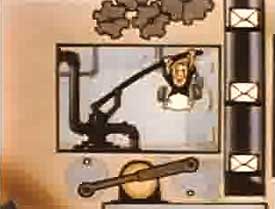 The twenty-minute propaganda film Medical Aspects of Nuclear Radiation (1950) has very little of medicine to it. It is targetted at youth & children & attempts to convince viewers that an atomic bomb may cause a lot of immediate damage from heat & wind, but there is no realistic risk from radiation.
The twenty-minute propaganda film Medical Aspects of Nuclear Radiation (1950) has very little of medicine to it. It is targetted at youth & children & attempts to convince viewers that an atomic bomb may cause a lot of immediate damage from heat & wind, but there is no realistic risk from radiation.
Most such films were little cheap black & white affairs of around ten minutes each. This one's two-reel length instead of one, plus it is in Technicolor, abeit today faded with time.
The setting of the film is "a sunlit school with all the trimmings." This otherwise unidentified California high school looks like a very expensive hotel retreat with Olympic pool & suntan seating.
A girl student during sunbathing class "exposes herself to solar radiation" with the sexualization of the kid pretty obvious. This is the film's first gambit in making school-aged civilians believe radiation is so good it even gives the babes of the school gorgeous tans.
Some of the kids viewing this, however, may be having trouble just getting beyond the complaint that their school has no sunbathing classes with babes in bathing suits.
An animation sequence showing molecules is designed to make kids feel like they know everything about radiation.
In order that the viewer understands the interaction of these radioactive molecules on human cell structure, we are shown a cut-away view of the human body, in which, I kid you not, itsy bitsy elves labor night & day at billows & crank-handles & pistons to keep our organs functioning.
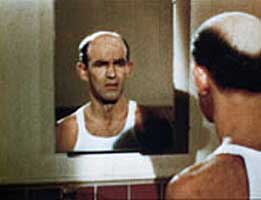 Sure, admits the narrator, radiation can cause the organs to shut down resulting in "death itself," but it might on the other hand cure you of cancer. Fear of radiation is likened to fear of "the evil spirits of the Indians." Smart people aren't worried at all, so you want to be a smart person, don't you? Sure, admits the narrator, radiation can cause the organs to shut down resulting in "death itself," but it might on the other hand cure you of cancer. Fear of radiation is likened to fear of "the evil spirits of the Indians." Smart people aren't worried at all, so you want to be a smart person, don't you?
Rules for safety include "Be somewhere else when it happens." And make no mistake, this film isn't being funny on purpose. But, it is confessed, "Under some conditions that's a hard rule to follow. Atomic warfare, for instance, might allow little choice in the matter."
So in that case, "If you can't stay away from it, you must stay with it, as safely as possible & properly protected."
There follows some animated mumbo jump about "proper protection" which seems to boil down to the idea that living in a reinforced concrete bunker will do the job. It goes from the animation to some guys in the bunker playing cards. Suddenly the bunker shakes from nuclear holocaust. They look up at the ceiling, shrug, & go back to playing canasta.
Radioactive fallout, we're assured, is only harmful if it is eaten or gets up your nose or in open wounds. "Eating only food that has been inspected & passed on" is therefore important, as is "guarding against breathing radioactive dust" & "care in handling contaminated articles."
The precise methods of food inspection, not breathing, & handling stuff gingerly, is a bit vague, though burying one's clothes in the back yard is enacted.
Radiation sickness, we're told, is easily treated. Treatment, however, the narrator says with unexpected glee, may involve removal of parts of the body. Penicillen will help if your immune system is gone. If baldness occurs, toupees are easily obtained. "An impressive share of radiation patients recover." Whew, what a relief.
A scientific looking pair of statistical pie-charts prove that if you worry 85% of the time about nuclear radiation, this is uncalled for, because only 15% of that worrying is justified. Damned but I would like to hear the response to that one if I could see this in a packed theater audience!
In summation nuclear bombs are only bigger but otherwise not worse than regular bombs, & mutations in one's offspring due to radiation exposure just might result in something better rather than worse, so it's just not something to worry over.
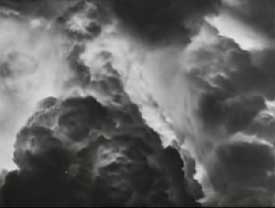 While the Department of Civil Defense was producing insane propaganda films for general public consumption, such as would've been totally useless had nuclear war really broken out, there were somewhat better films being made for the military's in-house use.
While the Department of Civil Defense was producing insane propaganda films for general public consumption, such as would've been totally useless had nuclear war really broken out, there were somewhat better films being made for the military's in-house use.
The full title of A Tale of Two Cities (1946), which couldn't possibly have been intentionally ironicly Dickensian, was Army-Navy Screen Magazine Issue No. 74: A Pictorial Report for the Armed Forces Only.
It wouldn't've done much good to tell the armed forces to just Duck & Cover (1951) in order to be perfectly safe, so this film shows the abject devastation of Nagasaki & Hiroshima.
Early in the narration is a prideful boast about cities cause to "vanish from the lists of living cities." With that brand of pride, we can expect there to be a lot less of the usual government underestimation of nuclear war as not really all that gruesome & easily survivable.
It's a funny thing when governments set out to tell whoppers. They may want everyone to believe our side & ours alone has the ultimate weapon & cannot be defeated in war, but military secrets are soon spread, & the government simultaneously wants its citizens to believe that if the same ultimate weapons are used against us, it'll be no big deal, we'll easily survive.
So this film tries to ignore any possibility of threat against Americans from nuclear war, which was an easier lie in 1946 than afterward when everyone knew Russia had these weapons too.
Hiroshima is likened an "arsenal city" ignoring that it was largely a civilian population. A typical set of photos shows the location of 20,000 military personel, all vaporized, leaving not even slight evidence of buildings & facilities or corpses. "They are among the missing" being the euphemism for complete obliteration.
The destruction of factories & a war memorial are proudly displayed, but not the schools wherein children were vaporized. Total focus on the nameless faceless "enemy" is maintained & the anihilation of property, not the people, is what this is mainly about, property that purportedly existed only to facilitate war, taken away from the enemy by "the atomic wind of death."
Special notice is made that the Red Cross Hospital suffered from the blast but not so much as to have to suspend operation. The implication is that anything innocent within the target was magically safe. If the hospital had been vaporized then the tone of the narration could've noted that it had been a hospital for military personel, but since it was still standing it was not mentioned as anything but the Red Cross & nothing military.
The truth about the Red Cross Hospital's "uninterupted" functionality was of course a little more complex. Most of the doctors & staff were killed outright, more died shortly after, & the enormous number of injured people who sought refuge in the ruinous hospital with even its steel frame twisted, they found little or no aid & died while waiting.
It became nationally known as "Atomic Bomb Survivors Hospital" & ten years later still specialized in treating survivors with crippling conditions. It is today on the cutting edge of bone marrow transplant operations which has special meaning for atomic bomb survivors.
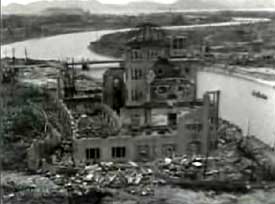 Three days later Nagasaki was hit. We're again assured this city was a place without civilians. Three days later Nagasaki was hit. We're again assured this city was a place without civilians.
Indeed, we're informed civilians were safe because the steel plant & the submarine works were in a valley & residential areas were protected by hills, so only industrial targets were harmed. The badly written text slips up when it alludes to "shadow" factories "hidden" in the residential areas also being hit.
Shamefully these lies are still being told in a new millenium. If this destruction was as necessary as the government believed, why is it then necessary to lie about it afterward?
It was as alleged a military center, true, but collateral damage included a university hospital, a prisoner of war camp. In Nagasaki as in Hiroshima the vast majority of victims were civilians inclusive of the elderly & small children.
The list of Japanese war crimes especially in Southeast Asia would be extensive & the argument that the bomb was or wasn't necessary is not one that I mean to address. But the majority in favor of it should be willing to face the truth of it. When constructing a "pride of destruction" piece of propaganda for soldiers' eyes only, however, those soldiers must not be permitted to humanize their targets or victims.
They deserved it, for "This was the funeral pyre of an aggressor nation." But even then the USA had Japan's future safety in mind & exploded the bombs high so that radioactive particles would be safely dissapated in the upper atmosphere. Oh what goodhearted Americans we all are! Oh what lovely news that fallout in the atmosphere is safe!
The soldiers buying this big dose of pride would later be intentionally exposed by their own military leaders to radiation at the Bikini Atoll & in Nevada just to see if they'd get sick or die. As many did.
Despite the gung-ho-happy-happy attitude of victoriously showing those slanty-eyed war-devils a thing or two about mass killing, this is one of the better films of the era. Overlooking its refusal to look at the human cost, it does show more than adequately the cost in property damage, at a level of obliteration that any thinking mind can surmise had an inconceivable human cost as well, however unspoken that may have been.
copyright © by Paghat the Ratgirl
|
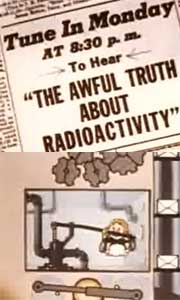

 Sure, admits the narrator, radiation can cause the organs to shut down resulting in "death itself," but it might on the other hand cure you of cancer. Fear of radiation is likened to fear of "the evil spirits of the Indians." Smart people aren't worried at all, so you want to be a smart person, don't you?
Sure, admits the narrator, radiation can cause the organs to shut down resulting in "death itself," but it might on the other hand cure you of cancer. Fear of radiation is likened to fear of "the evil spirits of the Indians." Smart people aren't worried at all, so you want to be a smart person, don't you?
 Three days later Nagasaki was hit. We're again assured this city was a place without civilians.
Three days later Nagasaki was hit. We're again assured this city was a place without civilians.